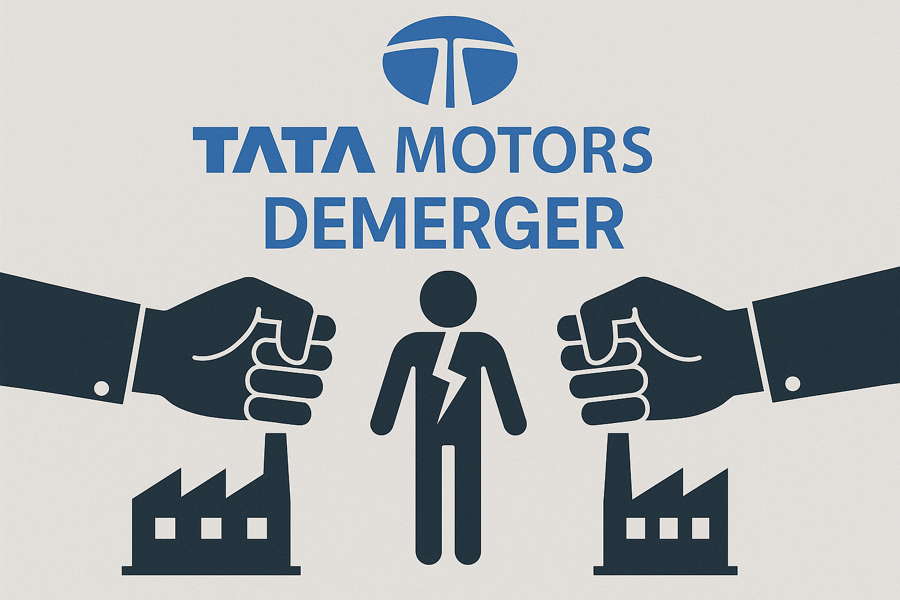
What Just Happened with Tata Motors?
Tata Motors has officially split into two separate companies—and it’s a big deal. This isn’t just a name change. It’s a strategic move to unlock value, attract the right investors, and give each business room to grow on its own terms.
The result? Two new publicly listed auto giants:
- Tata Motors Ltd (TML) — focused on Commercial Vehicles (CV)
- Tata Motors Passenger Vehicles Ltd (TMPVL) — home to Passenger Vehicles (PV), Electric Vehicles (EVs), and Jaguar Land Rover (JLR)
Let’s break down why the split happened, what it means for shareholders, and what to watch next.
Why the Demerger? Two Very Different Businesses
Imagine trying to evaluate a startup and a manufacturing giant in the same financial report. That’s what investors faced with the old Tata Motors.
- The CV business was a cash-generating, stable industrial operation.
- The PV/EV/JLR businesses were high-growth, tech-driven, and capital-hungry.
This mismatch led to a “conglomerate discount”—when the combined company was worth less than its individual parts.
By splitting them, Tata Motors created two “pure-play” companies:
- TML (CV) for value investors
- TMPVL (PV+JLR) for growth-focused investors
What Did Shareholders Get?
If you held Tata Motors stock before the split, here’s what happened:
- For every 1 original Tata Motors share, you now own:
- 1 share in TML (CV) and
- 1 share in TMPVL (PV+JLR)
- There was no dilution — you retained your ownership stake across both companies
This was done via a 1:1 share entitlement and approved by India’s National Company Law Tribunal.
What Are These New Companies Focused On?
Tata Motors Ltd (TML – CV Business)
- What it does: Trucks, buses, industrial vehicles
- Balance sheet: Net cash of ₹2,100 crore post-split
- Outlook: Strong domestic market share (37%) and a massive new acquisition on the horizon: a €3.8 billion all-cash deal for Iveco—which will make TML one of the world’s top 4 commercial vehicle makers
Tata Motors Passenger Vehicles Ltd (TMPVL – PV, EV, JLR)
- What it does: Passenger cars, electric vehicles, and the JLR luxury brand
- Balance sheet: High debt from JLR (~₹10,600 crore), though domestic PV/EV is cash positive
- Outlook: A mix of high-reward potential and serious short-term challenges. The JLR business is recovering from a major cyberattack, and its £18 billion EV strategy is under financial pressure
How Did the Market React?
The market loved the move.
- On Nov 12, 2025, TML (CV) listed at ₹335 — a 28% premium over its implied valuation
- TMPVL shares remained stable, trading around ₹404–₹409
- Together, the combined value of both entities rose 12%, proving the “value unlocking” thesis worked
Who’s Leading the Charge?
TML (CV): Led by Girish Wagh, a Tata veteran known for the Tata Ace and Nano. He now steers the company into its global CV expansion.
TMPVL: Headed by Shailesh Chandra, the architect behind Tata’s EV success. Meanwhile, PB Balaji, former Tata Group CFO, steps in as CEO of JLR, tasked with stabilizing the brand through a tough recovery
What Should Investors Watch Next?
For TML (CV):
- Integration of the €3.8B Iveco acquisition
- Execution of a ₹10,000 crore equity raise to fund global growth
- Continued benefit from India’s infrastructure boom
For TMPVL (PV+JLR):
- JLR’s return to normal production after the cyberattack
- Progress on the EV strategy and new Range Rover electric launch (now delayed to 2026)
- Managing capital demands during a period of near-zero free cash flow
Key Takeaways
- The Tata Motors demerger created two focused giants: one stable (CV) and one with high-growth potential (PV/EV/JLR).
- Investors gained immediate value, with shares of the two companies worth more combined than before.
- The CV arm looks like a strong long-term value play, while the PV/EV/JLR arm is a high-risk, high-reward turnaround story.
FAQs
Q: Is this like a stock split?
No. You still own the same total number of shares, but now in two separate companies.
Q: Will both companies trade on Indian exchanges?
Yes. TML (CV) and TMPVL (PV) are both listed on the NSE and BSE.
Q: Which company carries the JLR debt?
TMPVL. The JLR debt was ring-fenced into the PV/EV entity, leaving TML with a clean balance sheet
Q: What if I only want exposure to one side?
Now you can. That’s the point of the demerger — pure-play investing.
Final Thoughts
Tata Motors didn’t just split a company—it split a story.
On one side is TML, a disciplined, industrial powerhouse ready to go global. On the other is TMPVL, a high-tech, high-stakes EV player with luxury DNA and a lot to prove.
The choice for investors is clearer than ever. And for Tata, the road ahead just got a whole lot more focused.







